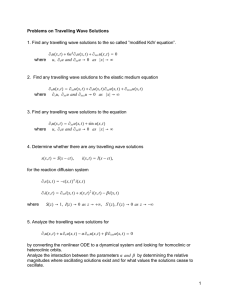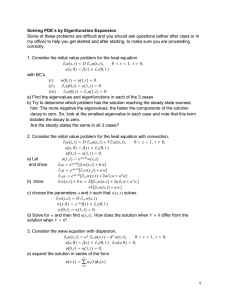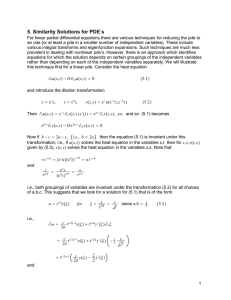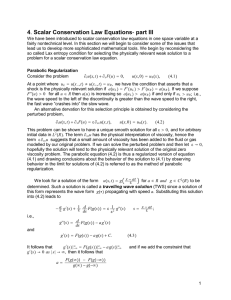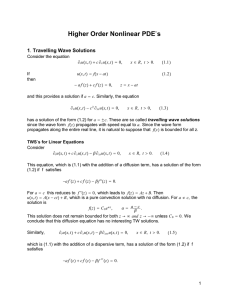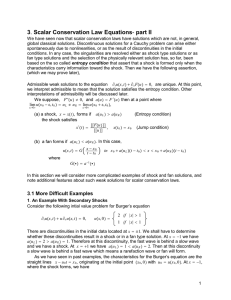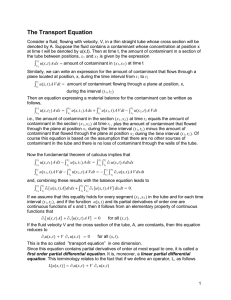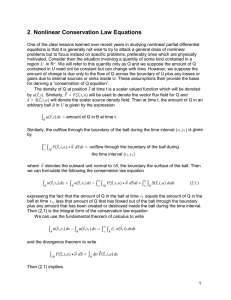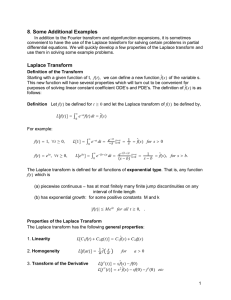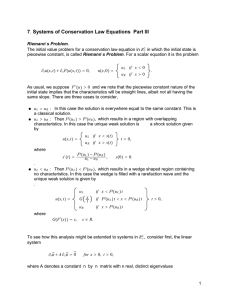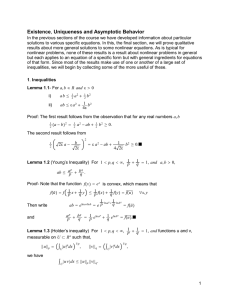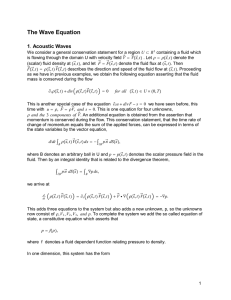2
advertisement
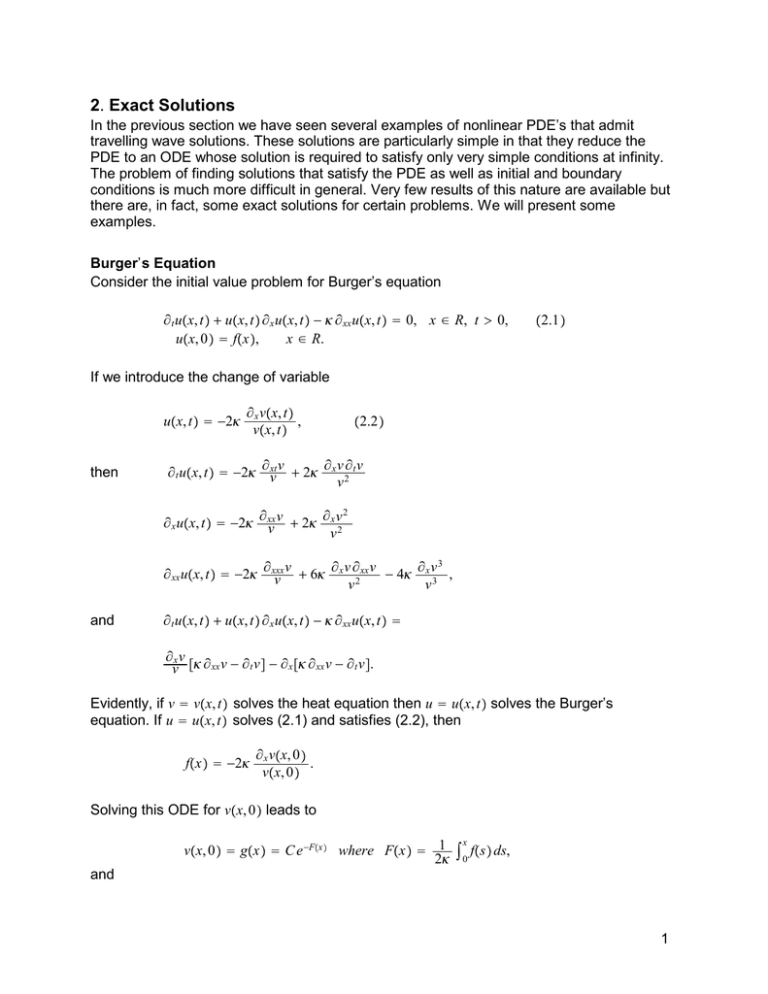
2. Exact Solutions In the previous section we have seen several examples of nonlinear PDE’s that admit travelling wave solutions. These solutions are particularly simple in that they reduce the PDE to an ODE whose solution is required to satisfy only very simple conditions at infinity. The problem of finding solutions that satisfy the PDE as well as initial and boundary conditions is much more difficult in general. Very few results of this nature are available but there are, in fact, some exact solutions for certain problems. We will present some examples. Burger’s Equation Consider the initial value problem for Burger’s equation / t uÝx, tÞ + uÝx, tÞ / x uÝx, tÞ ? U / xx uÝx, tÞ = 0, x 5 R, t > 0, uÝx, 0Þ = fÝxÞ, x 5 R. Ý2.1Þ If we introduce the change of variable uÝx, tÞ = ?2U then / x vÝx, tÞ , vÝx, tÞ Ý2.2Þ / t uÝx, tÞ = ?2U / vxt v + 2U / x v 2/ t v v v + 2U / x v 2 / x uÝx, tÞ = ?2U / xx v v2 v + 6U / x v / xx v ? 4U / x v 3 , / xx uÝx, tÞ = ?2U / xxx v v2 v3 and / t uÝx, tÞ + uÝx, tÞ / x uÝx, tÞ ? U / xx uÝx, tÞ = / x v / v ? / và ? / / v ? / và. t x ßU xx t v ßU xx Evidently, if v = vÝx, tÞ solves the heat equation then u = uÝx, tÞ solves the Burger’s equation. If u = uÝx, tÞ solves (2.1) and satisfies (2.2), then fÝxÞ = ?2U / x vÝx, 0Þ . vÝx, 0Þ Solving this ODE for vÝx, 0Þ leads to x vÝx, 0Þ = gÝxÞ = C e ?FÝxÞ where FÝxÞ = 1 : fÝsÞ ds, 0 2U and 1 vÝx, tÞ = Ýx ? sÞ 2 : gÝsÞ e 4Ut ds. ? C 4^Ut R Then u can be computed from v using (2.2). This rather remarkable transformation, reducing the nonlinear problem (2.1) to a linear initial value problem for the heat equation is called the Hopf-Cole transformation. This can be generalized slightly. Consider the following initial value problem, . x 5 R n , t > 0, Ý2.3Þ / t uÝx, tÞ ? a 4 2 uÝx, tÞ + b 4u 6 4u = 0, n uÝx, 0Þ = fÝxÞ, x5R , where a > 0. We let vÝx, tÞ = dÝuÝx, tÞÞ where d : R ¸ R is to be found. Now / t v = d v ÝuÞ / t u, 4v = d v ÝuÞ 4u 4 2 vÝx, tÞ = d ”ÝuÞ 4u 6 4u + d v ÝuÞ 4 2 u, / t v = d v ÝuÞ / t u = d v ÝuÞ ßa 4 2 uÝx, tÞ ? b 4u 6 4uà and = a 4 2 vÝx, tÞ ? Ýad”ÝuÞ + b d v ÝuÞÞ4u 6 4u. If we choose d such that a d”ÝuÞ + b d v ÝuÞ = 0, then v solves a (linear) heat equation. In particular, if bu v = dÝuÞ = e ? a , Ý2.4Þ / t vÝx, tÞ ? a 4 2 vÝx, tÞ = 0, bfÝxÞ vÝx, 0Þ = e ? a , then x 5 R n , t > 0, x 5 Rn. We find |x ? y| 2 bfÝxÞ vÝx, tÞ = Ý4^atÞ ?n/2 : n e 4at e ? a dy, ? R and uÝx, tÞ = ? a log vÝx, tÞ. b In the case n = 1 (2.3) becomes / t uÝx, tÞ ? a / xx uÝx, tÞ + b / x uÝx, tÞ 2 = 0, to which the transformation (2.4) applies. Note that wÝx, tÞ = / x uÝx, tÞ satisfies 2 / t wÝx, tÞ ? a / xx wÝx, tÞ + 2b wÝx, tÞ / x wÝx, tÞ = 0, which, if a = U and b = 1/2, is Burger’s equation (2.1). Then fÝxÞ |x ? y| 2 ? ?n/2 Ý4^UtÞ : e 4Ut e 2U dy ? uÝx, tÞ = ?2U log R and fÝxÞ |x ? y| 2 ? x ? y ? 4Ut : e e 2U dy wÝx, tÞ = R t 2 fÝxÞ |x ? y| ? ? : e 4Ut e 2U dy R which agrees with what was found by the first approach for solving the Burger’s equation. The connection between the two approaches becomes clearer when we note that the Hopf-Cole transformation can be broken into two steps as follows: iÞ uÝx, tÞ = / x fÝx, tÞ iiÞ fÝx, tÞ = ?2U log dÝx, tÞ, Ý2.5Þ Then / t uÝx, tÞ + uÝx, tÞ / x uÝx, tÞ ? U / xx uÝx, tÞ = = d dx d dx /tf + 1 2 / x f 2 ? U/ xx f /d /d d / d ? / d2 ?2U dt + 2U 2 Ý dx Þ 2 + 2U 2 Ý xx 2 x Þ d = ?2U dxd / t d ? U/ xx d d hence if d solves the heat equation, it follows that uÝx, tÞ solves Burger’s equation. Now consider the KdV equation, / t uÝx, tÞ + a uÝx, tÞ / x uÝx, tÞ + / xxx uÝx, tÞ = 0. Ý2.6Þ If we try to use the transformation (2.5), we let uÝx, tÞ = / x fÝx, tÞ then / t fÝx, tÞ + 1 2 a / x fÝx, tÞ 2 + / xxx fÝx, tÞ = 0. 3 Now let a fÝx, tÞ = 12 / x log dÝx, tÞ. d / x Ý/ t dÝx, tÞ + / xxx dÝx, tÞÞ ? / x d Ý/ t dÝx, tÞ + / xxx dÝx, tÞÞ This produces +3Ý/ xx d 2 ? / x d / xxx dÞ = 0. It is not what we had hoped for but, on the other hand, it is not difficult to show that dÝx, tÞ = 1 + e ?JÝx?sÞ+J satisfies 3t where J, s = parameters / t dÝx, tÞ + / xxx dÝx, tÞ = 0 / xx d 2 ? / x d / xxx d = 0 Although this leads to some particular solutions for the KdV equation that can be used to demonstrate the interaction of solitary waves, this does not provide a route to a solution for the initial value problem. Inverse Scattering Transform Let vÝx, tÞ = ? a uÝx, tÞ in (2.6). This reduces the equation to the more canonical form 6 / t vÝx, tÞ ? 6 vÝx, tÞ / x vÝx, tÞ + / xxx vÝx, tÞ = 0. Ý2.7Þ Now, the transformation (2.5), or equivalently (2.2) fails to reduce the KdV equation, Ý2.7Þ, to a linear equation. A slight modification of (2.2) is the transformation vÝx, tÞ = / xx f f + V. This also fails to reduce the equation but a new line of attack is suggested if the transformation is rewritten in the form / xx f + ÝV ? vÞf = 0 Ý2.8Þ The new approach is based on the observation that (2.8) is a Sturm-Liouville equation on the real line, a classical problem about which a great deal is known. In particular, for a given function v = vÝxÞ, v is referred to as the ”potential function” it is a classical problem to determine eigenvalues U n = V n and corresponding eigenfunctions fÝxÞ = f n ÝxÞ for (2.8). In connection with (2.7), we wish to consider v depending on both x and t, not just on x, but suppose we are interested in solving the initial value problem for (2.7). In this case we would be given vÝx, 0Þ = v 0 ÝxÞ Then we could begin by solving the S-L problem Ý2.8Þ for áU n , f n ÝxÞâ with the given potential function v = v 0 ÝxÞ. The next step determines how the eigenpairs áU n , f n ÝxÞâ vary if v is now allowed to depend on t. Amazingly, it is possible to show is that if vÝx, tÞ solves Ý2.7Þ then we are able to 4 calculate the time evolution of eigenpairs to get áU n ÝtÞ, f n Ýx, tÞâ for the time dependent problem / xx fÝx, tÞ + ÝVÝtÞ ? vÝx, tÞÞf = 0 where v = vÝx, tÞ solves Ý2.7Þ. The final step in solving the initial value problem makes use of another collection of classical results about the S-L problem, the results for the so called inverse problem. Finding the eigenpairs given the potential is called the direct or forward problem. The problem of determining the potential when the eigenpairs are known is called the inverse problem. The known eigenpairs are referred to as the scattering data, a term that is motivated by the physical problem of identifying an object from the reflection patterns it produces in response to impinging waves. What has been discovered is that for B = BÝx, tÞ a known function that is expressed in terms of the eigenpairs, we solve an integral equation for the unknown function K = KÝx, y, tÞ K KÝx, y, tÞ + : KÝx, z, tÞBÝz + y, tÞ dz = ?BÝx + y, tÞ x and then vÝx, tÞ = ?2 /KÝx, x, tÞ produces the scattering potential function associated with Ý2.8Þ. This multistep procedure is known as the inverse scattering transform. It applies to the KdV equation and to certain other equations but is not a general method that can be applied to all nonlinear equations. 5
